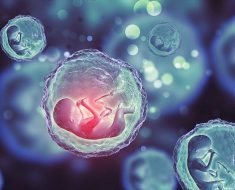When you've had your period for years upon years, you start knowing it (and your body) pretty damn well—like how you get incredibly annoying cramps three days before, or you feel like playing Lizzo's "Good as Hell" on repeat about a week or two after because you're feelin' yourself.
And while you know there's a method to your period madness (they call it a "menstrual cycle" for a reason), it can be pretty confusing to try to find out which specific day of your cycle you're on at any given moment—say, for example, if you're trying to conceive and are hell-bent on determining when you start ovulating.
Luckily, we've got your back. Here, an ob-gyn explains what exactly is up with your menstrual cycle, how long it can typically last, and all the different phases your body can go through in a month's time.
How long is a menstrual cycle?
So here’s the deal: The average timespan for a menstrual cycle is 28 days, but menstrual cycles aren't really a one-size-fits-all situation. Why? In the simplest terms, everyone is different, and cycles can even vary from month to month. According to the Office of Women’s Health (OWH), a division of the US Department of Health and Human Services, your period is still technically "regular" if it usually comes every 24 to 38 days.
Christine Greves, MD, an Orlando-based ob-gyn, has a slightly different estimate, that still gets the point across, saying a normal menstrual cycle can last anywhere from 21 to 35 days. "It can vary depending on the person," she says, adding that medications and certain conditions can affect the length of one's menstrual cycle. For example, birth control pills can affect the length of your cycle, as can weight loss and PCOS, Dr. Greves says. These factors can make a cycle longer or shorter than 28 days. Again, it's dependent on the individual.
Basically, the key here is that if an irregular period is normal for you, then it can actually be considered regular, as complicated as that sounds. Dr. Greves explains: "Everybody's different. As long as it's regular for [the patient], that's totally okay," she says. Something to keep in mind, though: If you start noticing some irregularities in your menstrual cycle—like if your cycle is consistently 29 days long every month and suddenly begins to last much longer—it's time to see a doctor to figure out what's going on.
What happens during a menstrual cycle?
I get it: It seems strange to put a random time limit on a natural bodily function—but in understanding your cycle (and how many days it typically lasts), it's helpful to think about that time in terms of the different phases of your menstrual cycle.
Let's start with day number one. The day you start bleeding, or the first day of your period, is technically the first day of your cycle. Your period typically makes up days one through five of your menstrual cycle, per the OWH. During this time, the lining of your uterus is shed by way of the vagina (if you’re not pregnant, of course). Simultaneously, during this phase, fluid-filled pockets called follicles develop on the ovaries, with each follicle containing an egg.
As your cycle goes on, one follicle in particular continues growing while the others stop and are absorbed back into the ovary. That follicle continues to grow while producing increasing levels of estrogen—and around day eight, those higher estrogen levels cause the lining of the uterus to grow and thicken, essentially getting ready to nourish an embryo.
Fast-forward to approximately day 14 (in a 28-day cycle, at least), which is when that growing follicle actually bursts to release an egg from the ovary. That process is called ovulation, per the OWH. (FYI: Ovulation typically makes your cervical mucus clearer and wetter, according to the UK's National Health Service.)
Over the next few days—days 15 to 24, again, in a 28-day cycle—the newly-released egg travels away from the ovary and towards the uterus. This time period is typically when you're the most fertile; if a sperm joins with the egg in the fallopian tube, it will become fertilized, travel the rest of the way down the fallopian tube, and attach itself to the uterine lining. (Pregnancy technically begins as soon as the fertilized egg is attached to the lining of the uterus, per the OWH).
If the egg isn't fertilized within a few days—approximately by day 24—the egg breaks apart. After that, your rising estrogen and progesterone levels drop, which is when most women experience those awful premenstrual symptoms like cramping, irritability, and anxiety. After that you’ll shed the lining of your uterus along with the broken-apart egg, and start the process (aka your menstrual cycle) all over again with your period. Sigh.
To get more real talk on health and wellness, sign up for our weekly WomenIRL newsletter
Source: Read Full Article





